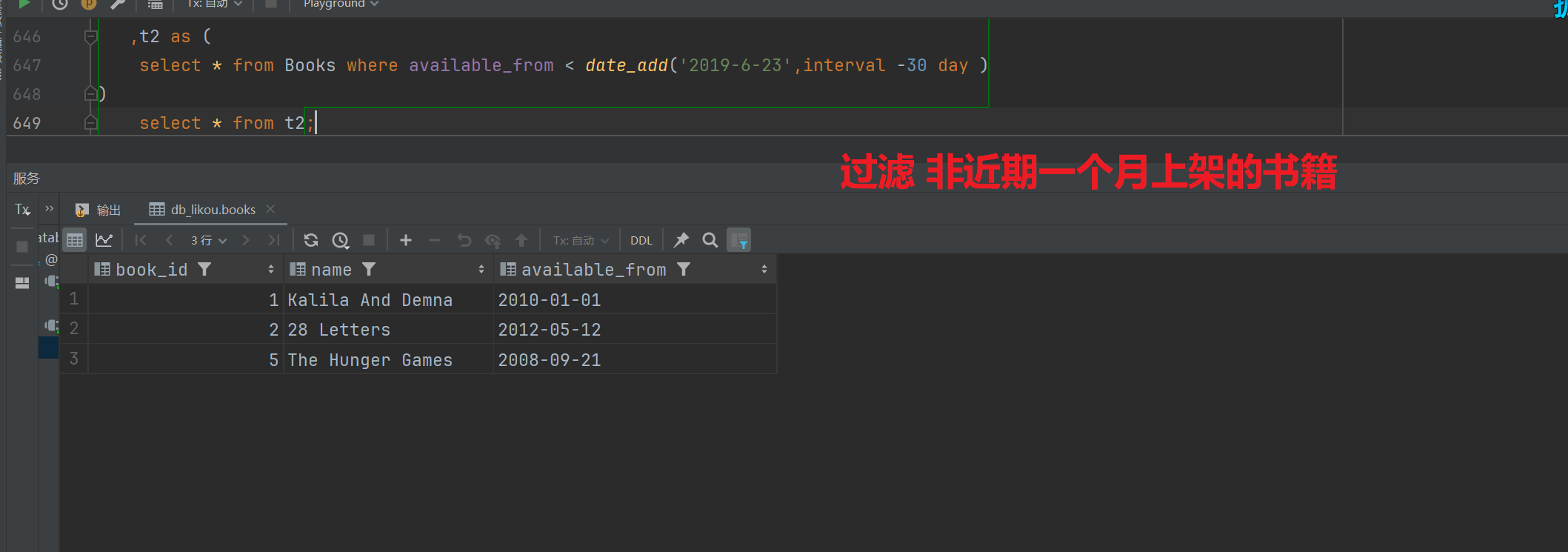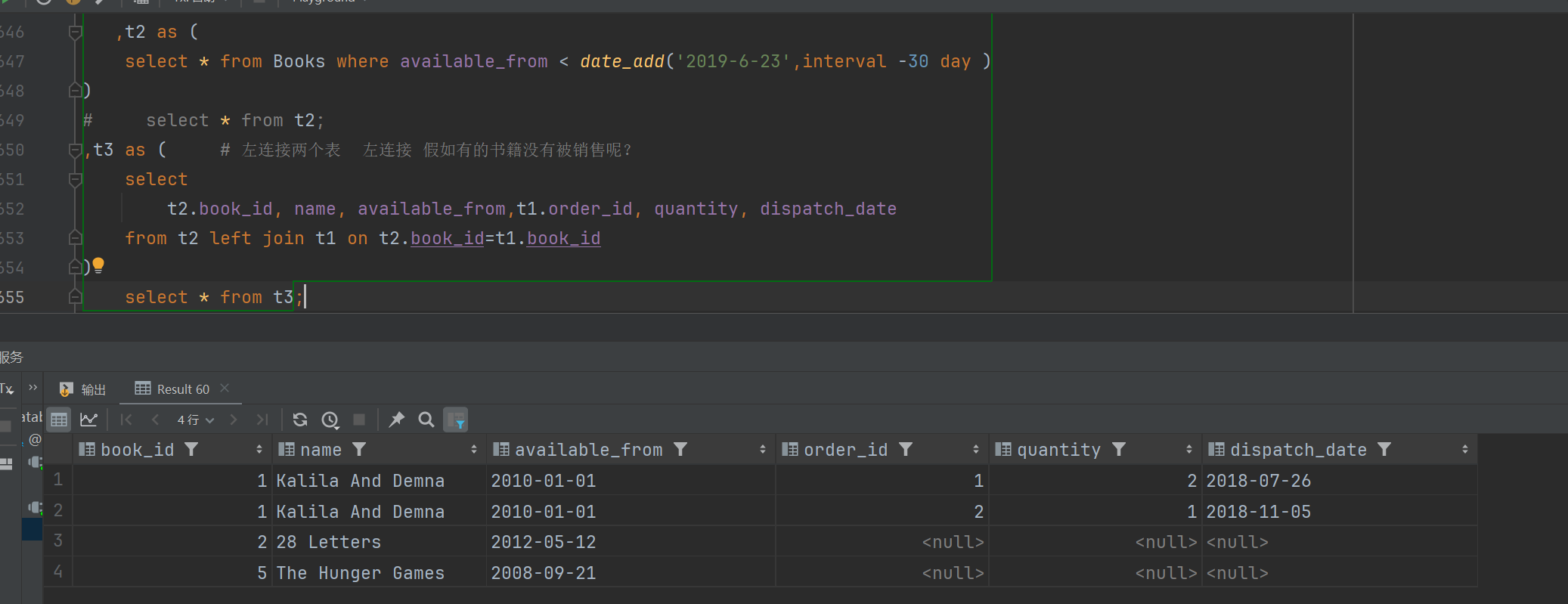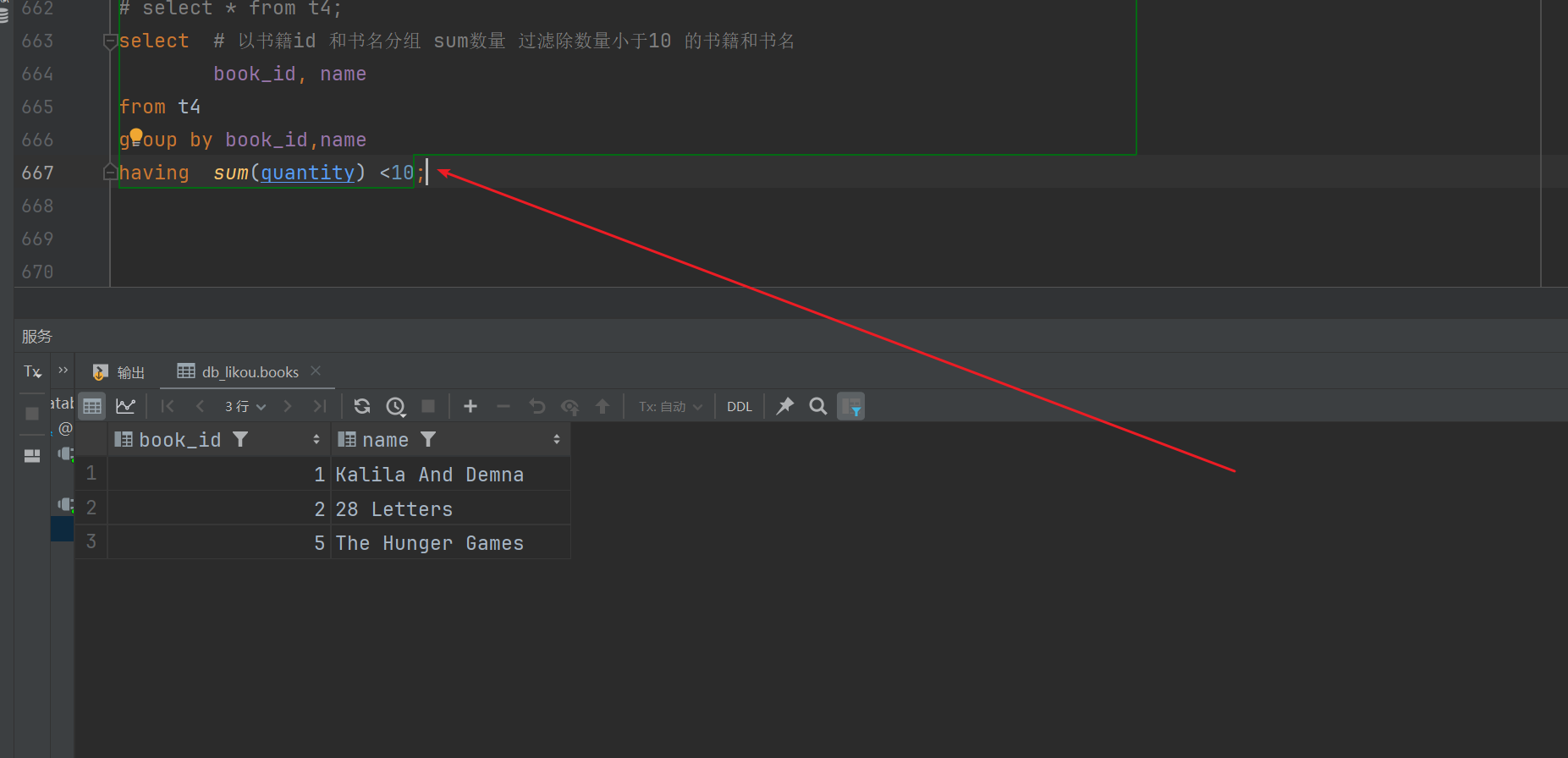- 学习:知识的初次邂逅
- 复习:知识的温故知新
- 练习:知识的实践应用
目录
一,原题力扣链接
二,题干
书籍表
Books:+----------------+---------+ | Column Name | Type | +----------------+---------+ | book_id | int | | name | varchar | | available_from | date | +----------------+---------+ book_id 是这个表的主键(具有唯一值的列)。订单表
Orders:+----------------+---------+ | Column Name | Type | +----------------+---------+ | order_id | int | | book_id | int | | quantity | int | | dispatch_date | date | +----------------+---------+ order_id 是这个表的主键(具有唯一值的列)。 book_id 是 Books 表的外键(reference 列)。编写解决方案,筛选出过去一年中订单总量 少于
10本 的 书籍,并且 不考虑 上架距今销售 不满一个月 的书籍 。假设今天是2019-06-23。返回结果表 无顺序要求 。
结果格式如下所示。
示例 1:
输入: Books 表: +---------+--------------------+----------------+ | book_id | name | available_from | +---------+--------------------+----------------+ | 1 | "Kalila And Demna" | 2010-01-01 | | 2 | "28 Letters" | 2012-05-12 | | 3 | "The Hobbit" | 2019-06-10 | | 4 | "13 Reasons Why" | 2019-06-01 | | 5 | "The Hunger Games" | 2008-09-21 | +---------+--------------------+----------------+ Orders 表: +----------+---------+----------+---------------+ | order_id | book_id | quantity | dispatch_date | +----------+---------+----------+---------------+ | 1 | 1 | 2 | 2018-07-26 | | 2 | 1 | 1 | 2018-11-05 | | 3 | 3 | 8 | 2019-06-11 | | 4 | 4 | 6 | 2019-06-05 | | 5 | 4 | 5 | 2019-06-20 | | 6 | 5 | 9 | 2009-02-02 | | 7 | 5 | 8 | 2010-04-13 | +----------+---------+----------+---------------+ 输出: +-----------+--------------------+ | book_id | name | +-----------+--------------------+ | 1 | "Kalila And Demna" | | 2 | "28 Letters" | | 5 | "The Hunger Games" | +-----------+--------------------+
三,建表语句
Create table If Not Exists Books (book_id int, name varchar(50), available_from date);
Create table If Not Exists Orders (order_id int, book_id int, quantity int, dispatch_date date);
Truncate table Books;
insert into Books (book_id, name, available_from) values ('1', 'Kalila And Demna', '2010-01-01');
insert into Books (book_id, name, available_from) values ('2', '28 Letters', '2012-05-12');
insert into Books (book_id, name, available_from) values ('3', 'The Hobbit', '2019-06-10');;
insert into Books (book_id, name, available_from) values ('4', '13 Reasons Why', '2019-06-01');
insert into Books (book_id, name, available_from) values ('5', 'The Hunger Games', '2008-09-21');
Truncate table Orders;
insert into Orders (order_id, book_id, quantity, dispatch_date) values ('1', '1', '2', '2018-07-26');
insert into Orders (order_id, book_id, quantity, dispatch_date) values ('2', '1', '1', '2018-11-05');
insert into Orders (order_id, book_id, quantity, dispatch_date) values ('3', '3', '8', '2019-06-11');
insert into Orders (order_id, book_id, quantity, dispatch_date) values ('4', '4', '6', '2019-06-05');
insert into Orders (order_id, book_id, quantity, dispatch_date) values ('5', '4', '5', '2019-06-20');
insert into Orders (order_id, book_id, quantity, dispatch_date) values ('6', '5', '9', '2009-02-02');
insert into Orders (order_id, book_id, quantity, dispatch_date) values ('7', '5', '8', '2010-04-13');
select * from books;
select * from Orders;四,分析



表格大法 先过滤在左连接 最后在分组过滤
第一步:过滤掉books表中上架时间距离如今一个月的书籍;
第二步:过滤 掉 订单表中 非近一年的订单;
第三步:以书籍表左连接订单表 统计书籍的销售数量 而非订单的,书籍有可能没有销售; 第四步:null值转为0
第五步,分组聚合过滤
第六步:映射指定的列 并输出;
第一步:过滤掉books表中上架时间距离如今一个月的书籍;
在mysql中:

第二步:过滤 掉 订单表中 非近一年的订单;
在mysql中:

第三步:以书籍表左连接订单表 统计书籍的销售数量 而非订单的,书籍有可能没有销售;
在mysql中:

第四步:null值转为0
在mysql中:

第五步,分组聚合过滤
在mysql中:

第六步:映射指定的列 并输出;
五,SQL解答
with
t1 as ( # 过滤掉 非近一年的的销售订单 提取过滤 利于查询
select
order_id, book_id, quantity, dispatch_date
from Orders where dispatch_date > date_add('2019-6-23',interval -1 year)
)
# select * from t1;
,t2 as (
select * from Books where available_from < date_add('2019-6-23',interval -30 day )
)
# select * from t2;
,t3 as ( # 左连接两个表 左连接 假如有的书籍没有被销售呢?
select
t2.book_id, name, available_from,t1.order_id, quantity, dispatch_date
from t2 left join t1 on t2.book_id=t1.book_id
)
# select * from t3;
,t4 as ( # 数量如果是null 就是0
select
book_id, name, available_from, order_id, ifnull(quantity,0) as quantity,
dispatch_date
from t3
)
# select * from t4;
select # 以书籍id 和书名分组 sum数量 过滤除数量小于10 的书籍和书名
book_id, name
from t4
group by book_id,name
having sum(quantity) <10;六,验证

七,知识点总结
- 时间差函数的运用 date_add 前一年
- 时间差函数的运用 上一个月
- 左连接的运用
- null值转为0的运用
- 分组聚合+过滤的运用
- 学习:知识的初次邂逅
- 复习:知识的温故知新
- 练习:知识的实践应用






















 208
208

 被折叠的 条评论
为什么被折叠?
被折叠的 条评论
为什么被折叠?








